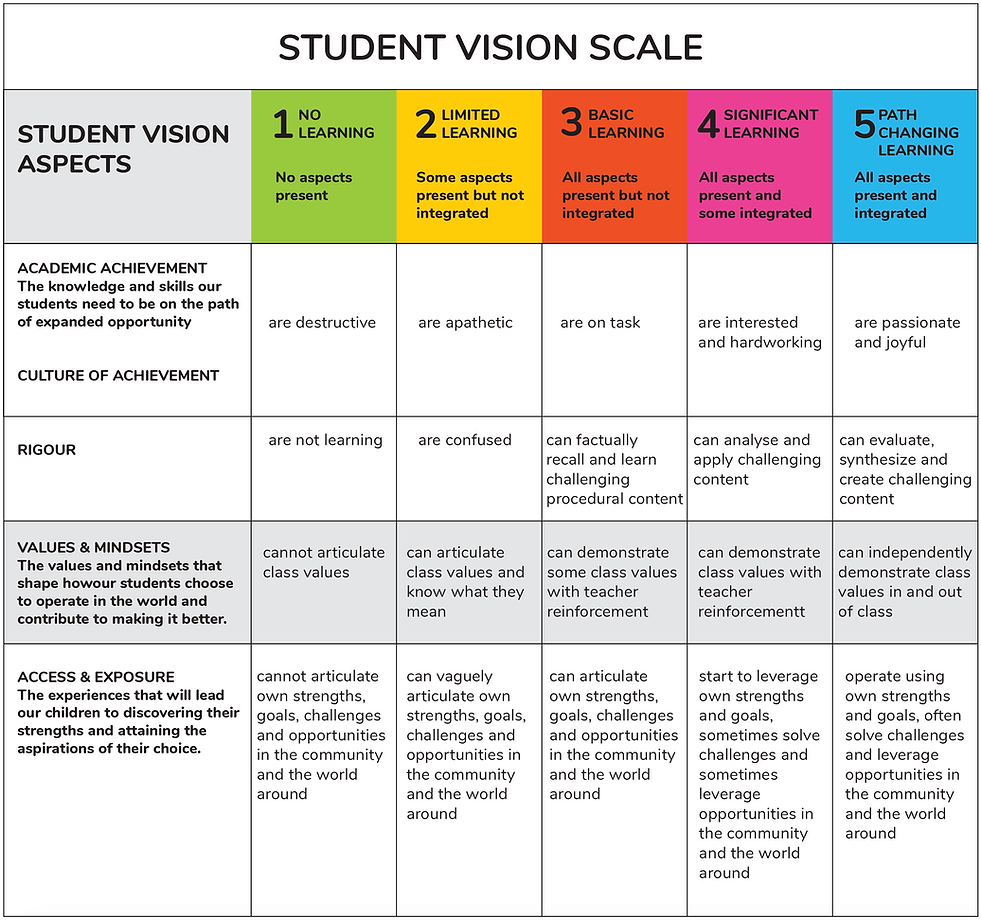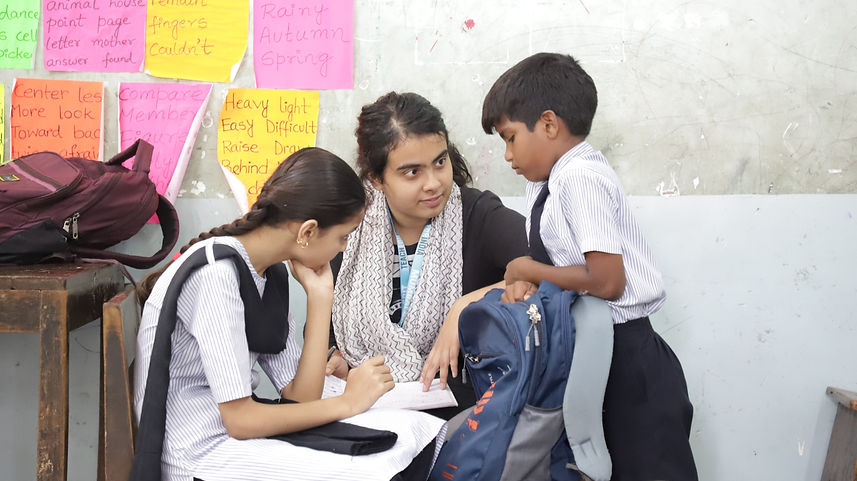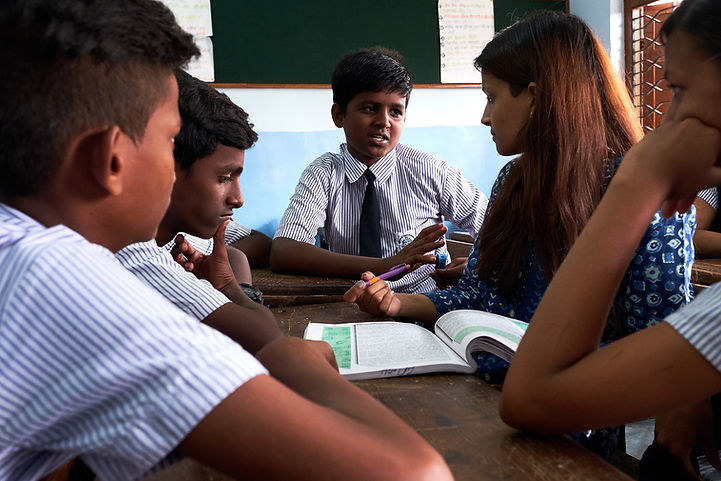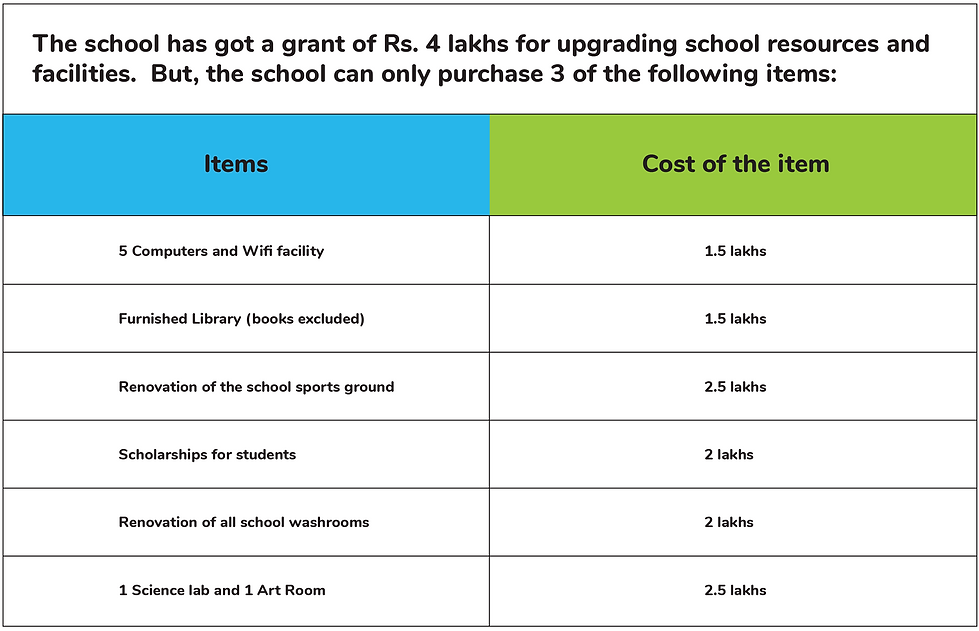Reimagining Your School
Act now to reimagine education!
Imagine how much better we’d make our schools if all of us worked together? Reimagine what your school can be by understanding what students want and then supporting your teachers and school administrators to make changes.
Here’s how you can start! Below you will find stories, learnings and exact steps you can try out to achieve what
these kids and educators did. Click on the resource that you'd like to learn and get started.
Let’s reimagine education together!
Seekho - Teachers of English Program (STEP)
A curriculum by kids, for kids
Even with existing textbooks, curriculums, and resources, India faces a large scarcity of effective teachers. One of the best ways to promote English fluency is to immerse students in an environment with fluent speakers, and STEP aims to enable prospective teachers across the country who have no prior teaching experience. That takes the initiative of individuals who bring communities of teachers and students together, using STEP as a foundation to bridge this socio-economic gap.

STEP is a pre collegiate English curriculum sequence, textbook series, and teacher guide for education of low-income students (9th–11th grades) in India. The project began in the American Embassy School (AES) in New Delhi, where underprivileged students were being taught as part of a high-school club. Seeing the students reach 10th grade and not have any curriculum to prepare them for college and beyond, a few student teachers in AES began developing a curriculum that coalesced a western educational approach with a curriculum contextualized in India. Over the next five years the curriculum was improved through interactions with the students under the supervision of a Ph.D in English education. It aims to build analytical fluency using a western approach to education in order to give underprivileged students the fluency they need to perform well in university and the workforce.
Through the process of teaching these students with the curriculum, over 30 have now gotten full-tuition scholarships to university. The culmination of these years has been published under the name STEP, and was presented at the TESOL international conference. It is no longer limited to the group of 120 students being taught at AES, and now NGOs and high schools across India are using this curriculum to teach. Through the design of the curriculum and the extensive teacher resources, it has been developed so that anyone can teach using the curriculum — even a high-school student or someone without formal teacher training.
How can you use this curriculum to begin teaching in your ecosystem?
Contact STEP at reachstep@gmail.com to receive access to all the free materials.
Inform them about your intentions and commitment to improving fluency in the English language for kids around you. You can also mention that you found this curriculum on the Kids Education Revolution website.
All of these materials and more are accessible for all, all you have to do is send them the e-mail and they will respond to you with the resources. No selection or application process is required.
All of these materials and more are accessible for all, all you have to do is send them the e-mail and they will respond to you with the resources. No selection or application process is required.
You can also visit their website, www.stepeducation.org for more information.
Whether you have teaching experience or not, the STEP curriculum is designed to help anyone create a learning environment tailored to their students. Each one of us has the potential to be a teacher, and STEP gives the resources on which to be a part of bridging the educational inequality in India.
How was your experience of using the STEP Curriculum?
KERx School
How can you Reimagine your School?
In May 2020, the KER Team launched the KERx School initiative to integrate the KER Principles into school structures. We partnered with 7 schools from Mumbai, Pune and Surat, and took them through a 3 day virtual immersion in collaboration with Reap Benefit. During this experience, the schools were introduced to KER’s vision, mission, 3 Principles and 8Cs. The schools also heard from KER Revolutionaries and went through a mini hackathon to experience the 8Cs in action. KERx School is a way to reimagine and immerse the KER Principles and values into your school structures. This resource will help you design your own KER program that can be implemented with all the students and teachers of your school.



After the Immersion, the KER Team conducted workshops with the 7 schools to brainstorm ways in which they could contextualize KER’s vision into their school structure. Each of the schools had a team of 10 individuals (5 students and 5 teachers) that took these ideas back and created plans that would fit their school’s current context.
Fountainhead School from Surat identified that they needed more student voice and ownership in their school so they started a Student Council which led 5 student clubs such as Changemakers, Events, and Social Emotional Learning (SEL). On the other hand, iTeach SVT and SGM from Pune started hobby clubs led by students and volunteers to focus on a more holistic learning and iTeach KRJ started theme based advisory circles co-led by students and teachers.
The KERx model aims to be very flexible and is based on the school’s current context.
How can your school become a KERx School?
Identify a core team of students and teachers to lead this initiative. You need to ensure that you have equal representation from both sides, and that all the individuals involved are active and passionate about causes like student voice and partnership. This will be the first space where you start incorporating the 3 KER Principles of Safe Spaces, Partnership and Changemaking!
To ensure that the group is aligned towards the same purpose, organize an Orientation session to introduce them to KER’s vision and mission, the 3 Principles and 8Cs.
It is very important that there is understanding and a Safe Space within the core team to ensure true Partnership. You can also conduct a few team building activities with the entire group to make sure that everyone feels comfortable and confident within the group.
Next, hold a session for brainstorming of ideas and structures. This should be an open space where the team practices Creativity and feels free to bounce their ideas off of each other.
Or you can design your own session. We recommend the following flow for the session -
Identify the current reality of your school
Spend some time to think of what your dream school would look like
Then, brainstorm ideas for how you can bridge the gap between the two.
The main purpose of this session isn’t to finalize the structures for your school, but to simply think about the various possibilities.
In the next meeting, ask the team to come with their ideas and after some discussion, choose a few ideas that the team thinks are both ambitious yet practical.
Take your finalized ideas and present them to the Principal, other staff members and students for feedback.
Brainstorm with the team and incorporate the feedback you received from the diverse stakeholders you presented your ideas to.
Now, you and your team are ready to set goals for these structures.
Assign different team members to each goal according to their strengths and divide the work amongst yourselves.
Think of different ways you can execute your ideas and achieve your goals. It’s time to plan!
The core team can also choose to onboard a few more teachers and students to put these ideas into execution.
The core team can come together every two weeks/month to share their progress to goals, challenges, and successes. These team meetings can be a space to celebrate as well as think of ways the work can be better.
Since KERx is an initiative to ensure more student voice and partnership in schools, it is essential to ensure that these structures are creating safe spaces for ALL the students in the school. The core team can take regular feedback from the students and teachers on the execution of these structures to see what’s working and what isn’t.
Let us know what you did to make your school into a KERx School!
Government School Exchange Program
Set up an exchange program between schools!
Vibha Nadig feels strongly about creating a more equal education system in terms of infrastructure and access to resources for all students of all schools. To facilitate this, she created a Government and Private School Exchange Program in partnership with Reap Benefit in order to increase mutual learning and sharing of resources between private and government schools. This resource will help you host such an exchange program between schools of your own city or community.
While in the 9th grade, Vibha worked with Pratham to create a holistic curriculum with multiple subjects, for kids who couldn’t go to school. Then she created this exchange program in 11th grade because she firmly believes in education equity and she hopes that these programs will increase mutual learning and sharing of resources between private and government schools. The program seeks to bridge the communication gap between students who study in government schools, and those who study in private schools.
How can you bridge the gap between private and government schools in your area?
Start by selecting two schools: a government school, and a private school. Make sure that these schools are close to each other as that will make it easier to plan and carry out activities.
Visit both schools and make a list of all the resources they have, for example, a library with the number of and kind of books, a playing field or a sports court such as a tennis court, a laboratory with the type of apparatus available, etc.
Understand the schedules of both the schools, and identify one day a week where the exchange can happen when both schools are free.
In partnership with the educators of your school, learn the following skills of creating
A vision document
A long-term plan
A unit plan
A weekly plan
Lesson plans
Create the above mentioned documents for the program. Keep in mind the following notes for the planning -
For the first exchange, make sure there is a good team building activity (maybe a treasure hunt) to get students from both schools to bond.
Through the course of the program, plan for a problem solving project that the students from both schools can work on together, such as setting up waste segregation units in both schools.
You can use the following rubric to measure the impact of the Exchange Program. It is our evolving understanding of an excellent education and monitoring our student growth in the form of a rubric - The Student Vision Scale

Pitch your program and the plan to the respective principals of both the schools.
Once the schools are on board, facilitate the first exchange either in the government or private school.
The exchange every week should alternate between the two schools.
Monitor the changes and let the kids take it forward!
Let us know how your exchange program was!
Student Advisory Committee - Kids in governance

A Student Advisory Committee involves kids in the decision-making processes of an organization / school / classroom. This committee provides an opportunity for kids and educators to work in partnership and collectively make decisions that affect each other.

Nalika and Nishi, two staff members at Teach For India, formed a Student Advisory Committee for the Teach For India Mumbai team in 2018. They decided to do this when they realized there was a dearth of student involvement and contribution in how the Teach For India Fellowship program in Mumbai is designed and run. This resource outlines the selection process that goes into forming a Student Advisory Committee.
Open the applications for the committee to the members of your organization/school/classroom so that interested students can sign up.
For the first round of selection, collate the list of students who’ve signed up and divide them into groups. Feel free to decide the number of students in each group. The students will be participating in the following simulation activity for 15 minutes where they will need to behave as the Student Advisory Committee of the school.

For the second stage of the process, conduct personal interviews by asking 3 to 4 of the following questions to each of the participants -
Please introduce yourself and tell us about your likes, dislikes and hobbies.
Why do you want to join this committee?
Why do you think a student committee is important?
What is your understanding of a Reimagined Education?
Who according to you is a Student Leader?
Role Play: You have a 5 day vacation. You have to convince your school principal to let you conduct extra classes for 2 hours per day for Grade 10 Math and Geography.
A group of boys and girls from your classroom have been seen throwing trash in the school and on the road outside the school. This group of boys and girls had been warned by the school twice but they have still continued to throw garbage around. As a part of the Student Advisory Committee, how will you address this situation? If you get a chance to prepare your class timetable, what changes will you make to the time table and why?
Next, give the students one of the two following writing topics -
Your neighboring class has 85 kids with only 1 teacher to teach them the entire day. The teacher is very passionate about teaching and planning different activities for the kids. But the kids are always seen disturbing, screaming, shouting and running around when the class is going on. The teacher tries many ways to calm and settle the kids down, but it has never helped. Thus, she was not able to complete the portion. Then she realised that the only way the kids would quiet down and listen to her is if she hits the students with a stick. But according to the law, school authorities cannot physically hurt school children as a form of punishment. How would you deal with such a situation?
According to the law in India, no child can be failed till Grade 9 in government schools. This law was made to make sure that every child is given a chance to catch up with their gap in learning by the time they reach Grade 9. However, you have seen few students from Grade 8 and Grade 9 who are unable to read and write. They find it very difficult to read their textbooks as they find the English language very difficult to understand. The teachers feel that if these kids stay back in the grades before Grade 8, it would allow teachers to focus on them independently, which is not possible once the kids come into Grade 8 and Grade 9. As a Student Advisory Committee member, how will you approach this situation?
For each round, the students will be scored on the scale of 1 to 5 for the respective selection criteria. The selection criteria for each round is as follows -
Group Discussion: The student’s engagement with the discussion, listening skills, and overall behaviour.
Personal Interview: The students’ communication skills, body language, and overall attitude.
Writing Assignment: The students’ ability to articulate their rationale, express their empathy, and display the clarity in their ideas.
Upon reviewing the scores, decide the list of students that will form your Student Advisory Committee and release the results!
Let us know how the Student Advisory Committee has been working in your school!
Each One Teach One Fellowship
Create a Fellowship for kids in your school to provide an
excellent education to all kids
The Each One Teach One Fellowship is a program for kids that belong to the higher grade classrooms in a school where they teach younger kids. This resource will help you build student leaders in your school who will be able to upskill their leadership, facilitation, and planning skills. This fellowship program was started by two student leaders - Hajeera and Sindhupriya from Grade 9 in Hyderabad.
Sindhupriya and Hajeera’s school was running a peer to peer mentorship program. After realising that the program was resulting in very slow progress, they decided to initiate morning meetings in some of the younger classes at their school. Morning meeting is an engaging way to start each day, build a strong sense of community and set children for success by setting goals around their academics and behaviour. This created a space where a slightly larger group of students could all come together and learn from each other. By asking the students tough questions, spurring discussion and organising activities to keep the engagement levels up these two girls continue to push the bar for rigour in their classroom.
How can you build a Fellowship for kids in your school?
Open up applications for kids from the highest grade in your school to apply.
Follow the steps from forming a ‘Student Advisory Committee’ to select the fellows for your Each One Teach One Fellowship.
With your new Fellows, conduct a survey in your school to understand where kids and other educators need the most help.
Host an orientation session with your selected Fellows where you collectively decide how you can support the kids and educators of your school.
In partnership with the educators of your school, learn the following skills of creating
While creating your plans also decide the way you want to record or document your impact. Here is our best understanding of an excellent education and monitoring our student growth in the form of a rubric like this Student Vision Scale.
A vision document
A long-term plan
A unit plan
A weekly plan
A lesson plan
To build the selected fellows into stronger educators of the future, the fellows’ growth can be tracked using their
reflections on the ‘Fellow Commitment Scale’ at different points in the year.
To build the selected fellows into stronger educators of the future, the fellows’ growth can be tracked using their
reflections on the ‘Fellow Commitment Scale’ at different points in the year.

To build the selected fellows into stronger educators of the future, the fellows’ growth can be tracked using their reflections on the ‘Fellow Commitment Scale’ at different points in the year.

Don’t forget to celebrate the successes of each Fellow!
Please share with us the journey of your Each 1 Teach 1 fellows!




